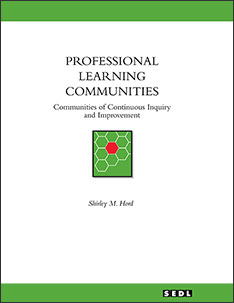The Learning Community Evolves
In both the private corporate world and the public education sector, attention in the eighties began to focus on the influence of work settings on workers. Rosenholtz (1989) brought teacher workplace factors into the discussion of teaching quality, maintaining that teachers who felt supported in their own ongoing learning and classroom practice were more committed and effective than those who did not. Support by means of teacher networks, cooperation among colleagues, and expanded professional roles increased teacher efficacy for meeting students' needs. Further, Rosenholtz found that teachers with a strong sense of their own efficacy were more likely to adopt new classroom behaviors and that a strong sense of efficacy encouraged teachers to stay in the profession. In a similar vein, Fullan (1991) focused on the teacher workplace and recommended a "redesign [of] the workplace so that innovation and improvement are built into the daily activities of teachers" (p. 353).
McLaughlin and Talbert (1993) confirmed Rosenholtz's findings, suggesting that when experienced teachers had opportunities for collaborative inquiry and its related learning, the result was a body of wisdom about teaching that could be widely shared. Adding to the discussion, Darling-Hammond (1996) cited shared decision making as a factor related to curriculum reform and the transformation of teaching roles in some schools. In such schools structured time was provided for teachers to work together in planning instruction, observing each other's classrooms, and sharing feedback.
Darling-Hammond observed that such teacher workplaces were "embryonic and scattered" (1996, p. 10) but added that attention to redesigning the way teachers spend their time and to rethinking teacher responsibilities is greater now than at any time in the past. McGreal, responding to a question about getting beyond individualism and isolation from other adults (in Brandt, 1996) also observed that he sees more collaboration and more collegial conversation among school staff than ever before. Further, he judged that "schools are getting better - a lot better" (p. 33) as a result.
The private sector has devoted considerable attention to the workplace and its culture. Deal and Kennedy (1982) reported how business and private industry managers used cultural factors to bring about change with staff. And, parallel with the educational researchers noted above, organizational theorists working in corporate America have espoused similar ideas about workplace factors. The work of Senge (1990), Block (1993), Galagan (1994), Whyte (1994), and others emphasizes the importance of nurturing and celebrating the work of each individual staff person and of supporting the collective engagement of staff in such activities as shared vision development, problem identification, learning, and problem resolution. In the business sector, this way of operating has been labeled learning organization.
The business literature has reinforced the schooling literature as educators have investigated the methods by which corporations operate and the ways business managers and staff interact to stay on top of customer demands. Currently, the educational consumer is making demands ever more long and strong. "Schools are now expected not only to offer education, but to ensure learning" (Darling-Hammond, 1996, p. 5), and high-quality learning at that.
Darling-Hammond reminded us that in the past, educators selected the right textbook and curriculum programs to bring about improvement. These programs were "teacher-proofed" with abundant prescriptions for what teachers should do. Although much study and investment were given to the change process and how to put programs into practice in classrooms, too frequently only rhetorical attention was given to this process.
The result was short-term schoolwide change efforts that lacked the full participation of school staff. Nurturing staff's willingness to change so that improvement is continuous has been an ongoing challenge to would-be leaders of school change.
Thus, new initiatives are looking to a new strategy - professional learning communities - for adopting and implementing potentially powerful programs and practices for students. Teachers will need to engage in schoolwide collegial activities and in joint professional efforts that have children's learning as their purpose (Jalongo, 1991). This strategy involves investing in teacher preparation and professional development, as well as permitting greater autonomy and decision making for teachers. What might this look like in a school?
Next Page: Attributes of Professional Learning Communities

